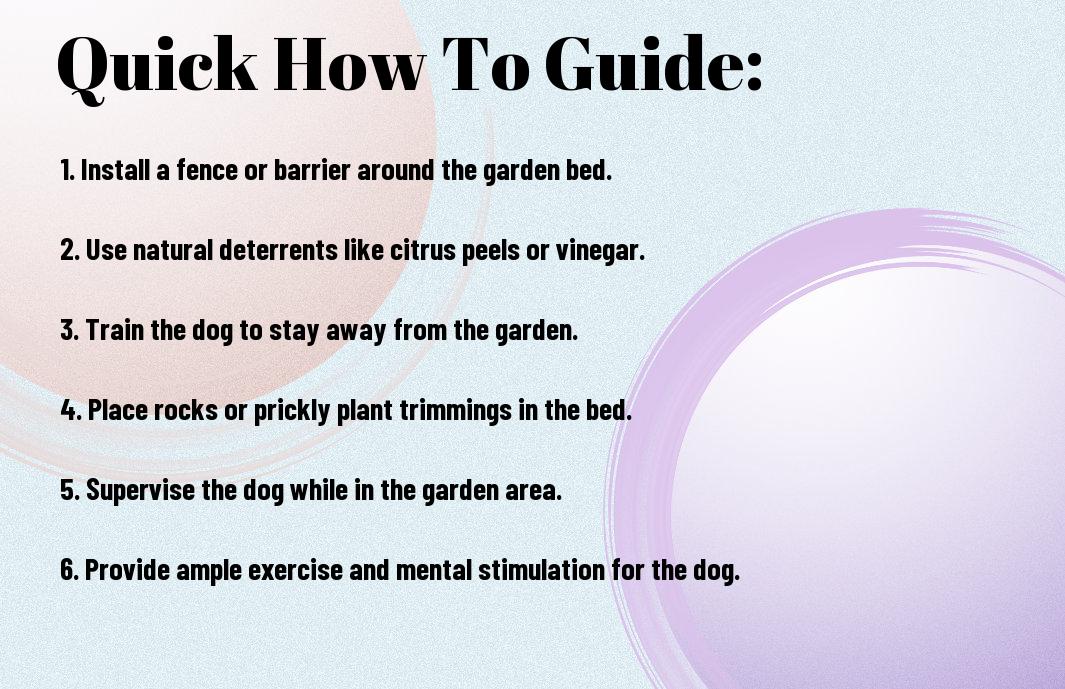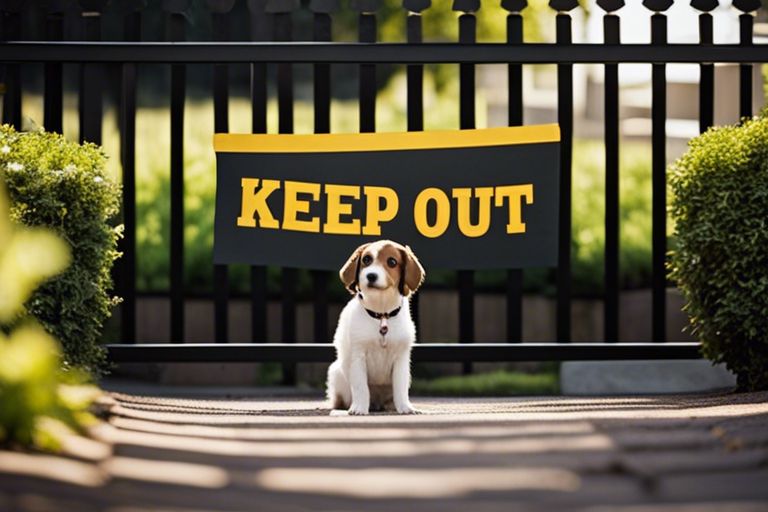Plants blooming beautifully in garden beds can be a source of pride and joy for any gardener. However, the presence of a curious or playful dog can sometimes lead to unwanted digging, trampling, or nibbling on your precious plants. If you’re looking for effective ways to keep your dog out of your garden beds and preserve your green oasis, we’ve got you covered. Follow these proven methods to create a dog-proof garden and maintain the beauty of your outdoor space.
Key Takeaways:
- Use physical barriers: Installing fences, chicken wire, or raised beds can help keep dogs out of your garden beds.
- Use natural deterrents: Place citrus peels, coffee grounds, or vinegar around the garden bed as dogs often dislike these smells.
- Train your dog: Teach your dog to stay out of the garden beds by using positive reinforcement techniques and redirecting their behavior to other areas.

Understanding Your Dog’s Behavior
Factors influencing a dog’s attraction to garden beds
Even though every dog is unique, there are common factors that can influence their attraction to your garden beds. Understanding these factors can help you implement effective strategies to keep your furry friend out.
- Scent: Dogs have a keen sense of smell and are attracted to the scents of plants and soil in your garden.
- Curiosity: Dogs are naturally curious animals and may investigate new areas like your garden beds.
- Comfort: Some dogs may find garden beds to be a comfortable spot for rest or play.
This understanding is crucial in devising a plan to deter your dog from entering the garden beds.
Recognizing signs your dog is likely to invade the garden
Recognizing signs that your dog is likely to invade your garden can help you take proactive measures to prevent it from happening. Look out for behaviors such as sniffing around the garden, digging in specific areas, or showing excessive interest in plants and flowers. If you notice these signs, it’s time to take action to protect your garden.
Recognizing these behaviors early on can help you intervene and train your dog to stay away from the garden beds. Consistent training and positive reinforcement can go a long way in teaching your dog boundaries and keeping your garden safe.

Creating Physical Barriers
Tips for choosing and installing fences
Once again, when it comes to keeping your dog out of the garden bed, fences can be an effective solution. When choosing a fence, make sure it is tall enough to prevent your dog from jumping over and strong enough to withstand any attempts to dig or push through. Installing the fence securely in the ground is crucial to prevent your furry companion from finding a way under or through it. Consider materials that are durable and weather-resistant for long-term effectiveness.
- Choose a fence that is at least 4 feet tall.
- Opt for materials like metal or composite that are difficult to chew through.
- Install the fence deep into the ground to prevent digging underneath.
Knowing your dog’s behaviors and tendencies can help you select the most appropriate fence for your garden bed. Regularly inspect and maintain the fence to ensure it remains sturdy and intact.
Alternative barriers: nets, raised beds, and plant cages
You may also consider alternative barriers such as nets, raised beds, and plant cages to keep your dog out of the garden bed. Netting can be draped over the plants to prevent access or raised to form a barrier above the bed. Raised beds can elevate the plants out of your dog’s reach, while plant cages can protect individual plants from being trampled or dug up.
Raised beds provide a physical barrier that is both visually appealing and functional in keeping dogs away from delicate plants. They also offer the added benefit of better drainage and soil quality for your garden bed.
Training Your Dog
Establishing garden boundaries
Your garden can be a tempting playground for your furry friend, but it’s necessary to establish clear boundaries from the get-go. With consistent training and reinforcement, you can teach your dog where they are and are not allowed to go. Consider using physical barriers like fencing or raised beds to clearly mark the limits of their play area.
Positive reinforcement and deterrents
Any successful training regimen involves a mix of positive reinforcement and deterrents. Reward your dog with treats and praise when they follow the rules and stay out of the garden bed. Additionally, consider using deterrents like motion-activated sprinklers or pet-safe repellents to deter them from entering the restricted area.
Garden beds can be easily damaged by digging and chewing, so it’s crucial to be consistent with your training methods. Bear in mind, patience and consistency are key to successfully keeping your dog out of the garden bed.
Plant Selection and Garden Design
Dog-repelling plants
Many plants have natural scents that dogs find unpleasant, which can help deter them from entering your garden beds. Examples of dog-repelling plants include lavender, rue, and coleus canina. These plants not only add beauty to your garden but also serve a practical purpose in keeping your furry friend at bay.
Strategic garden layout to discourage canine intruders
There’s a way to design your garden layout that can naturally deter dogs from entering certain areas. Planting densely or creating pathways of sturdy plants like rosemary or boxwood can create physical barriers that dogs are less likely to navigate through. Additionally, placing prickly plants like holly or barberry along the perimeter can discourage curious pups.
Even incorporating raised garden beds can make it more challenging for dogs to access your precious plants. Dogs are less likely to jump up onto raised beds, especially if they are surrounded by hardscaping or other features that dogs find less appealing.
Plus, incorporating pathways or designated walkways for both you and your dog can help define boundaries and keep your pet from wandering into areas where they shouldn’t be. By planning out the layout of your garden with your dog in mind, you can create a harmonious space that benefits both you and your furry friend.
Additional Preventative Measures
How to use natural repellents
Not all dogs are deterred by physical barriers, so using natural repellents can be a great supplement to your garden bed protection plan. These can include sprays made from vinegar, citrus, or important oils like citronella or eucalyptus. Be sure to test a small area first to ensure your dog isn’t bothered by the scent.
Incorporating safe, dog-friendly play areas
Measures to prevent your dog from accessing your garden beds can be enhanced by providing designated play spaces in your yard. By incorporating safe, dog-friendly play areas with toys, shade, and comfortable bedding, you can redirect your dog’s energy and focus away from your garden beds. Consider installing dedicated dog playground equipment or a sandbox for digging.
Creating a safe play area not only benefits your garden beds but also contributes to your dog’s overall well-being by promoting physical activity and mental stimulation. By establishing boundaries and providing engaging activities, you can ensure your dog’s happiness while protecting your garden beds.

Maintenance and Monitoring
Routine checks and adjustments to barriers
Despite putting up barriers to keep your dog out of the garden bed, it’s important to regularly check and adjust them as needed. Dogs are crafty creatures and may find ways to wiggle through or around barriers over time. By conducting routine checks, you can ensure that the barriers remain effective in keeping your dog at bay.
Keeping your dog engaged and exercised
If you want to prevent your furry friend from venturing into the garden bed, keeping them engaged and exercised is key. Dogs are more likely to wander off and explore when they are bored or full of pent-up energy. By providing regular playtime, walks, and mental stimulation, you can help redirect their focus away from the garden bed.
Keeping your dog engaged while also providing them with enough physical activity can significantly reduce their interest in digging or exploring areas they shouldn’t be in. This not only benefits the well-being of your garden but also contributes to your dog’s overall health and happiness.
Summing up
Drawing together various techniques such as using barriers, natural repellents, training, and creating a designated play area for your dog, it is possible to keep your furry friend out of your garden beds. By combining these strategies and being consistent with their application, you can effectively protect your plants and flowers while ensuring your dog’s safety and well-being. Remember that patience and positive reinforcement are key when implementing these methods, and with time, you will establish a harmonious balance between your garden and your beloved canine companion.
FAQ
Q: Why is it important to keep dogs out of garden beds?
A: It is important to keep dogs out of garden beds to protect your plants from being trampled or dug up, and to prevent dogs from potentially coming into contact with harmful pesticides or fertilizers.
Q: How can I train my dog to stay out of the garden bed?
A: One effective way to train your dog to stay out of the garden bed is to create a designated digging area for them in another part of the yard and consistently redirect them to that spot whenever they approach the garden bed.
Q: What physical barriers can I use to keep my dog out of the garden bed?
A: You can use barriers such as fences, chicken wire, or raised garden beds to physically block your dog from accessing the garden bed. Be sure to secure the barriers firmly to prevent your dog from knocking them down.
Q: Are there any natural deterrents that can help keep dogs out of the garden bed?
A: Yes, you can use natural deterrents like citrus peels, cayenne pepper, or vinegar around the perimeter of the garden bed to deter dogs with their strong scents. Just be cautious with these methods if you have sensitive plants.
Q: How should I respond if I catch my dog in the garden bed?
A: If you catch your dog in the garden bed, use a firm “No” command and promptly redirect them to their designated digging area or another acceptable area. Consistency is key in reinforcing the desired behavior of staying out of the garden bed.
